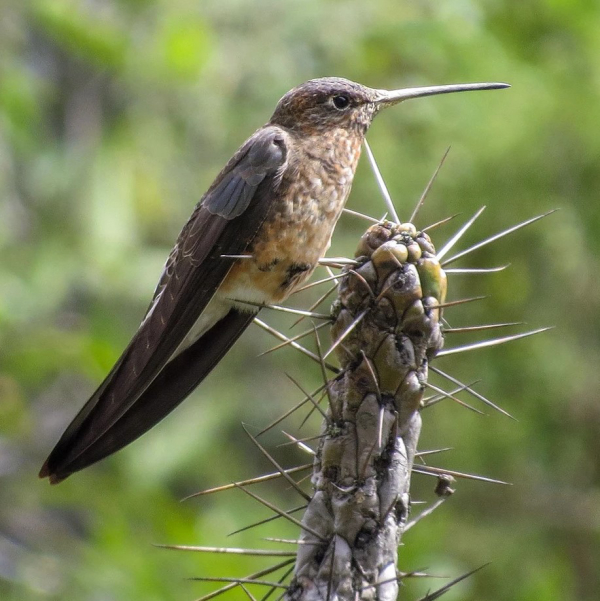
This exciting photo of the largest hummingbird, the Northern Giant Hummingbird, was taken by researcher Jessie Williamson.
|
Giant Hummingbirds are the largest of the 363 species of hummingbirds – all found in the Western Hemisphere. Giant Hummingbirds range in western South America in the high Andes Mountains of Ecuador and Peru to coastal areas of south-central Chile. An interesting aspect about Giant Hummingbirds is that their range extends across the broadest range of environments of any hummingbird species. However, recent field studies using ultra-small geolocators to track individual Giants and associated physiological studies of individuals from the 2 primary “populations” have provided evidence that there are actually 2 different species of Giant Hummingbirds!
A new study published in the Proceedings of the National of Academy of Science and described in the most recent issue of Audubon magazine, documents that extreme elevational migration spurred speciation in Giant Hummingbirds. It was imperceptible until the migration and genomes were studied, revealing that the high-elevation resident Giants are actually the world’s largest hummingbird, and a new separate species, which the researchers suggest naming the “Northern Giant Hummingbird.”
To try to crack the mystery that has long surrounded the migratory “Southern Giants” that vanished after each nesting season, Dr. Jessie Williamson assembled an international team of researchers. Beginning by engineering a tiny geolocator “backpack” that weighed only 0.3 grams to ensure it wouldn’t hinder what she believed could be a migration spanning thousands of miles, the team tagged 57 Giant Hummingbirds with the geolocator satellite transmitters.
The information provided by the geolocators showed that during winter, the southern “population” of Giant Hummingbirds live among the non-migrating “population” resident in the Peruvian Andes. This allowed the birds to blend in and essentially disappear among the northern Giants. Also, the information provided by the first tracked Giant Hummingbird indicated that individual completed the longest recorded migration of any hummingbird – a 5,200-mile round trip between the Chilean coast and the Peruvian Andes!
As if that information wasn’t remarkable enough, the specifics of the bird’s migration up and down the exceptional elevation changes in the Andes Mountains suggested deeper differences between the 2 hummingbird “populations” beyond their ranges and movements. During its migration, the geo-tagged bird ascended a total of 13,000 feet, pausing at various intervals for days to acclimate its blood and lungs to the lower oxygen levels, much like human mountaineers. This behavior revealed a key evolutionary difference between the Northern and Southern “species.”
The northern non-migratory Giant Hummingbirds that inhabit the Andean highlands year-round, possess a greater total lung capacity and different blood composition than their southern counterparts. But it’s not just the northern birds’ lungs that are bigger; upon closer inspection, the non-migratory hummers measured slightly bigger in all morphological traits, including bill length, wing length, and tail length, thus making the Northern Giants the largest hummingbirds in the world.
Genetic analysis revealed that the species diverged evolutionarily millions of years ago, though it’s unclear whether the migratory trait was adopted by one species or lost by the other. As a result of all the new information, the researchers have proposed “splitting” the present Giant Hummingbird species into 2 different species, thereby re-naming the non-migratory species the Northern Giant Hummingbird, and the migratory birds the Southern Giant Hummingbird.
While Dr. Williamson’s team of researchers have provided an exceptional level of information about the Giants, especially when combined with what is expected to be the resulting split of the species it may put an end to the initial mystery. But there is no question that the new information will also encourage biologists to ask new questions, as they are now intrigued by the evolutionary paths and divergent physiologies of these impressive hummingbirds. New questions and resulting research studies are surely on the horizon.
To learn more about this interesting story you can refer to the original Audubon article at Scientists Discover World's Largest Hummingbird Hiding in Plain Sight | Audubon and you can access the original research publication at Extreme elevational migration spurred cryptic speciation in giant hummingbirds | PNAS